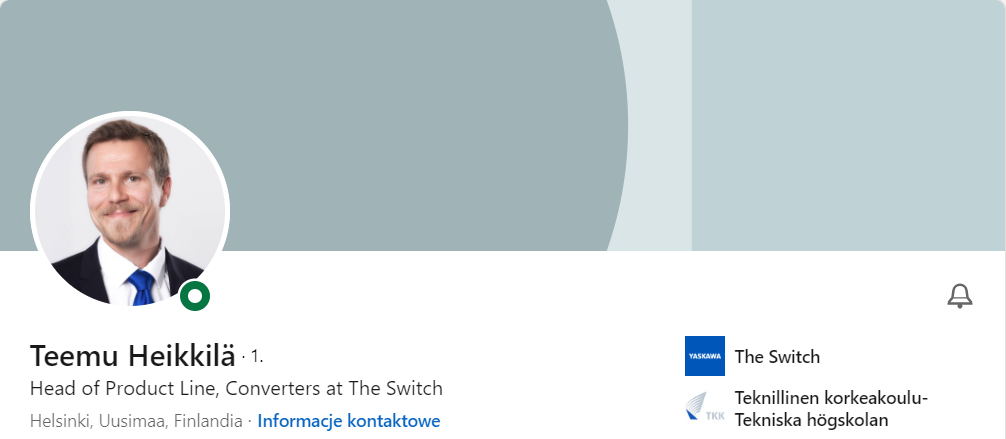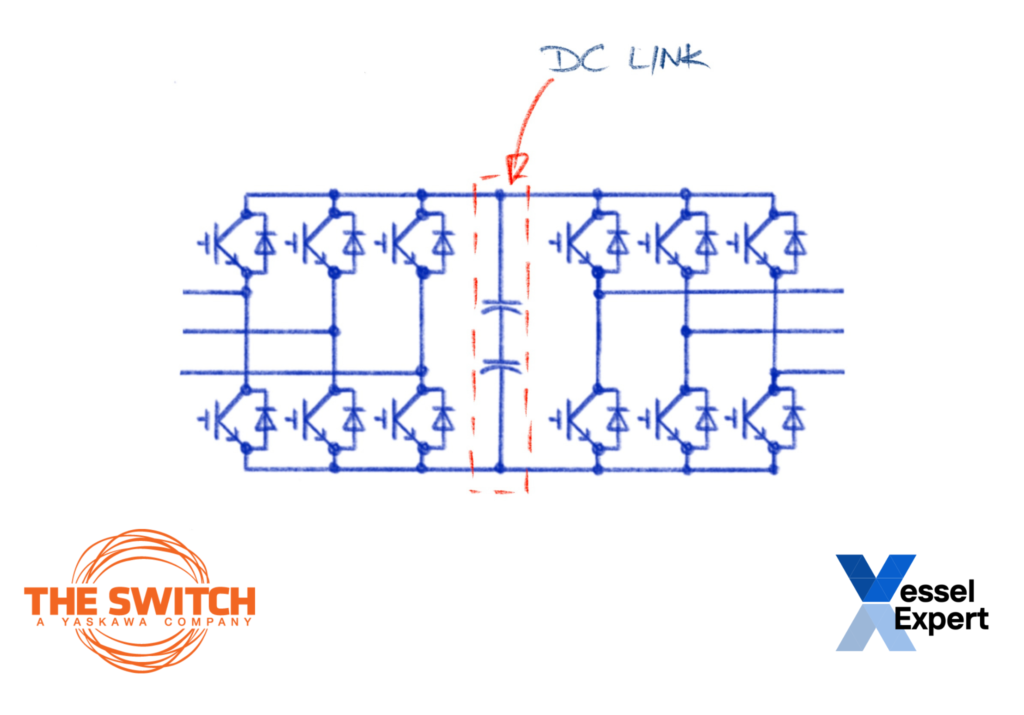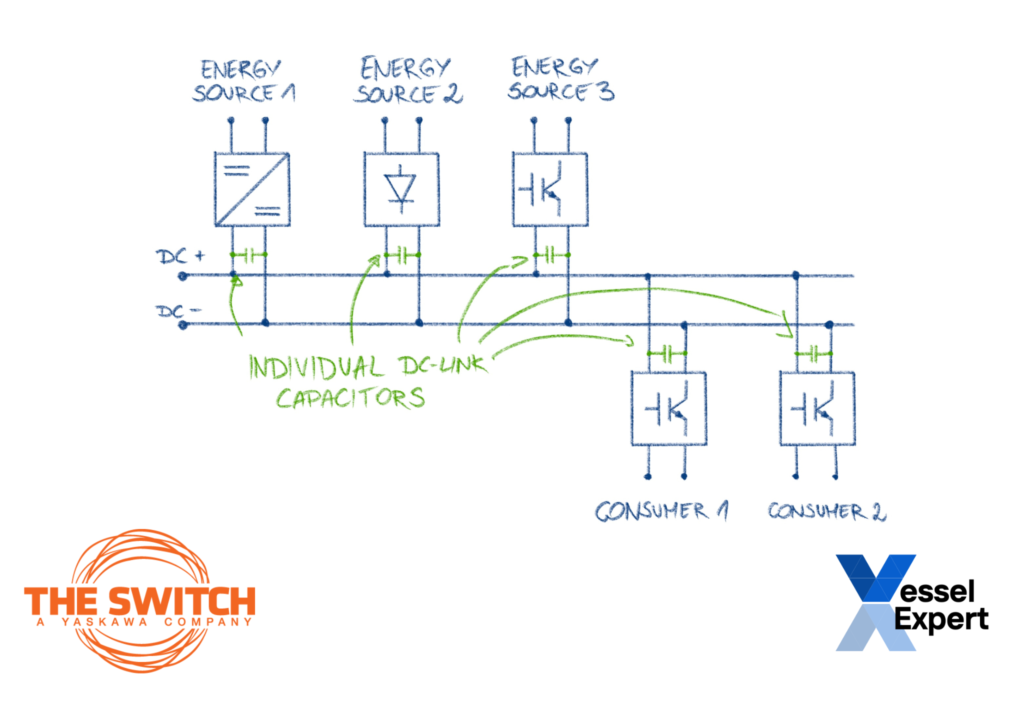This is our third article in the hybridization series and the second part of the DC distribution system article. In the previous part, our guest Teemu Heikkilä answered the questions about the DC distribution in general. We discussed how DC differs from AC distribution, its economic benefits, where the market is heading and what regulations are already in place. This time, we will dive more into technology.
Teemu Heikkilä

For those who skipped the first part of the interview, Teemu is an expert in DC distribution systems. His current position is Head of Product Line, High Power Converters at The Switch / Yaskawa Environmental Energy. He has been working with drives for almost two decades, always close to product development.
Common DC link in DC distribution
Mateusz: Last time, you mentioned that energy sources and consumers share a common DC link in the DC distribution system. Why do we convert energy from AC to DC and then back to AC? And why do we need a common DC link?
Teemu: In the AC system, the frequency converter also converts energy from AC to DC and back to AC. It just happens inside one drive, so it is not that obvious.
In the DC system, there are fewer conversions, and a DC link is used to transfer energy. So all the applications have either AC to DC or DC to AC conversions. Sometimes, it can even be DC to DC or a direct connection.
In short, in DC distribution, all applications have one conversion toward a DC link where power is transferred. In AC grids, you have two conversions.

Mateusz: This way, we can cut the energy conversions to half. But still, this takes a lot of converters, which is an issue for power quality. What about power quality in those systems?
Teemu: Power quality is slightly different in AC and DC systems. In AC, total harmonic distortion (THD) is essential. In DC, everything is connected to a common DC link. For this reason, the focus needs to be on system stability and the elimination of all kinds of oscillations between applications. Due to the capacitive nature of a DC link, this is a known challenge.
Challenges in DC distribution
Mateusz: What challenges or limitations do we need to keep in mind when dealing with DC-grid systems?
Teemu: I would say focusing on system redundancy and stability is essential. When you connect all the applications to a common DC link, system-level power flow and all the fault scenarios need to be considered carefully.
Mateusz: How to deal with emergency situations in a DC distribution system? Are emergency generators still a valid option?
Teemu: First, the system needs to have redundancy. It can be built in several ways. In the electrical DC system redundancy, ultrafast protection devices play a big role. They ensure that the fault is eliminated immediately and let the rest of the system run as before.
Often, systems are a combination of AC and DC. Usually, an emergency generator is connected to an AC system to ensure critical consumers.

DC behavior requires unique protection devices
Mateusz: How would we protect the system from those fault scenarios?
Teemu: The behavior of a DC system is different from AC. Applications are connected to a common DC link through power electronics, such as inverters. Inverters include capacitor banks. In addition, energy sources are connected to the same DC link. And there are fewer, if any, current limiting components, like transformers.
As a result, the time constant of the fault current in the system is short. This means that short-circuit currents reach high values very rapidly. Plus, the current does not have zero crossing in DC, which is an additional challenge for protection.
All these factors create a need for ultrafast and predictable protection. Conventional technologies like fuses and breakers are not fast enough for DC. And if protection is not fast enough, the consequence is a drop in DC voltage, which will trip all the applications connected to the common DC link.
Mateusz: Do we have a solution for those issues?
Teemu: This is why we have developed a family of ultrafast protection devices. These block high short-circuit currents to protect inside the DC-Hub (EDCB), between DC-Hubs (EBL), toward the battery (ECL) and from the battery (BSCL). Our unique protection devices also allow the ride-through and implementation of large batteries into the system.
Energy storage systems
Mateusz: Taking into consideration all the challenges, what would be the most efficient solution?
Teemu: The power flow from different energy sources to consumers needs to be controlled. Since DC distribution allows easy integration of different energy sources, the most efficient solution is combining “slow and fast energy sources.” In this case, most of the energy is generated by “slow energy sources,” while “fast energy sources” take care of peak powers.
Energy storage is a key component in this scenario. In addition, with a closed EBL operation, you can share energy between the DC-Hubs. This makes it possible to use regenerative energy anywhere in the system.
Mateusz: I see that DC distribution plays a big role in the integration of energy storage systems.
Teemu: Yes. DC distribution is an optimal choice to connect different technologies, such as different energy sources, together.

Mateusz: Can you explain the role of energy storage systems (ESSs) in the DC-grid systems? How do ESSs provide backup power or peak shaving?
Teemu: The response time of the ESS is shorter than that of the auxiliary generators. Therefore, they are optimal to take care of load peaks. This enables generators to run at an optimal load point with optimal fuel consumption. A combination of slow and fast energy sources is very efficient.
Mateusz: Like, for instance, with permanent magnet shaft generators?
Teemu: The combination of shaft generators and batteries is a good and practical example.
As mentioned previously, in the PTO mode, energy storage can be charged. And it is more efficient to charge it from the main engine through the shaft generator than run an extra genset. In PTI, energy can be taken out from storage to give extra power. In PTH, the main engine is disconnected from the shaft line and can be operated fully electrically by a shaft generator and a battery.
DC distribution system design
Mateusz: Knowing all that, what we learned from both parts of the interview, could You walk us through the process of designing the DC distribution system in general?
Teemu: In my opinion, everything starts from the operation profile. That defines the need and optimal solution at the end of the day. DC-distribution system is interesting as there is not that clear one right solution. It will give you more options compared to the AC system.
Mateusz: What is your approach to the problem?
Teemu: Our approach is to use standardized building blocks for different functions which we can configure in a flexible way for project needs. It is like a building system out of Legos. So basically, we configure DC distribution out of these building blocks and then iterate design together with Customers who are system integrators to find optimal power flow in each operation. As said there is no that clear right and wrong solution in DC distribution but you can do things more flexibly depending on your operation profile. This needs to be done in close cooperation with the system integrators’ power management system.

Maintenance
Mateusz: Is it easy to maintain the system? Will the crew be able to do it by themselves when it comes to replacing spare parts or servicing?
Teemu: I can comment only on our system. We have paid special attention to easy and fast service, as this is very essential for the marine industry. For instance, we have implemented fast connectors for the inverter modules. This means there is no bolt connection in the main power path while installing the modules. This makes installation fast and reliable.
We also have IP44 enclosed in our module. If failure happens, the module will keep all the damage. You just change the module with fast connectors and start the system again. There is no need for cleaning inside the cabinet, which is very time consuming.
We have made the system simple so that even the crew can service it, if necessary.
Electrification continues at full scale
Mateusz: What are the latest developments in the field of hybridization and energy-efficient solutions on board the vessels?
Teemu: A lot is happening. Already today, batteries have become standard in DC distribution. And we can also see an increase in the implementation of other green energy sources, like fuel cells. Permanent magnet machines are also worth mentioning.
Mateusz: What is the future of hybrid ships? Which direction are we going right now?
Teemu: I think it depends on what kind of fuels are available in the future to reach IMO targets. But it is clear that electrification will continue at full scale, and energy efficiency plays a crucial role here.
In my opinion, we’ll see a wider range of different energy sources combined with DC distribution. Then, it is a matter of the vessel type and operational profile to decide which ones are used for which application.
Mateusz: Teemu, thank you for the interview. It was a pleasure to get insights into DC technology from the expert.

Conclusions on Part 2
DC distribution allows us to half the energy conversions within the system. This contributes to better energy efficiency and power quality.
When dealing with such systems, we need to focus on system stability and the elimination of oscillations between applications.
Due to the capacitive nature of a DC link and the absence of current limiting components on the DC side, ultrafast protection devices play a crucial role in ensuring system redundancy.
Among its vast benefits, DC distribution also allows easy and simultaneous integration of various future and present energy sources. These include shaft generators, energy storage systems, auxiliary gensets and more.


